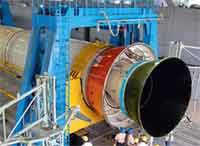Kinetic
BANNED

- Joined
- Feb 12, 2010
- Messages
- 11,200
- Reaction score
- -33
ISRO successfully tested world's third largest solid rocket booster S-200 for GSLV mk III. This is the second successful ground test of the booster.
S200 solid booster contains 200 tonnes of solid propellant in three segments. The motor measures 22 meter long and 3.2 meter in diameter. The design, development and successful realisation of S200 solid booster were a pure indigenous effort involving Vikram Sarabhai Space Centre, Thiruvananthapuram and Satish Shawan Space Centre (SDSC) at Sriharikota with the participation of Indian Industries.
You can see the thrust vectoring of the nozzle! The booster was fired for 130 seconds against actual requirements of 103 seconds.
S200 solid booster contains 200 tonnes of solid propellant in three segments. The motor measures 22 meter long and 3.2 meter in diameter. The design, development and successful realisation of S200 solid booster were a pure indigenous effort involving Vikram Sarabhai Space Centre, Thiruvananthapuram and Satish Shawan Space Centre (SDSC) at Sriharikota with the participation of Indian Industries.
You can see the thrust vectoring of the nozzle! The booster was fired for 130 seconds against actual requirements of 103 seconds.

Last edited by a moderator:






 Thank you guys for giving my post so much attention.
Thank you guys for giving my post so much attention.
